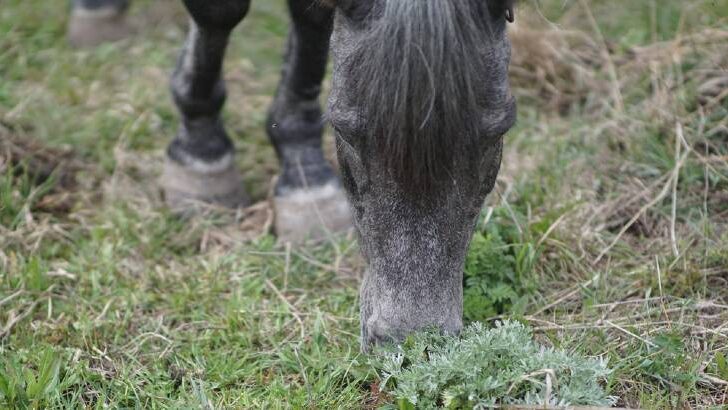Affiliate Disclaimer
As an Amazon Associate I earn from qualifying purchases. It helps me keep the website going. Thank you for your support.
As a horse owner, you already know the importance of maintaining your horse’s hooves. You check and clean them often, and organize regular farrier visits to trim or shoe them. However, have you ever wondered how wild horses maintain their hooves without our help?
Wild horses maintain their hooves as they move around in search of food and water. By traveling long distances each day, they are able to wear down their hooves to prevent overgrowth. Wild horses also encounter a variety of different terrain. Areas that are rocky, stony, sandy, or hard, along with river crossings, all help in maintaining a healthy horse hoof.
Having healthy hooves is vital to your horse’s health and well-being. Read on to learn more about how wild horse hooves and their maintenance differ from those of your own horse.
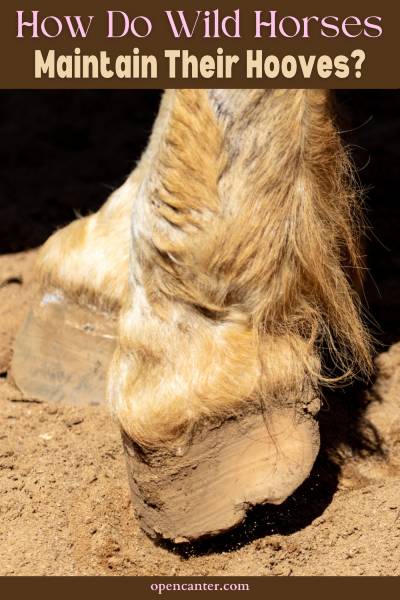
A Little Bit About Horse Hooves
Before we delve into how wild horses maintain their hooves, let’s take a look at the structure of the hoof. Hooves are very complex and are vital to a horse’s survival.
Here are the external parts of the horse hoof:
- Hoof wall: Looking from the outside in, you will first see the hoof wall. This is made of keratin, the same as our own fingernails. This part of the hoof grows continuously and has no feeling.
- Coronet band: this is where the hoof wall meets the skin at the top of the hoof.
- White line: This is where the hoof wall joins onto the sole and sensitive internal structures.
- Sole: This is the smooth area of the bottom of the hoof that is usually slightly concave.
- Bars: These are extensions of the hoof wall. They run in two diagonal lines on either side of the frog.
- Frog: The triangular-shaped cushion found in the middle of the hoof. It acts as a shock absorber and also aids in circulation.
- Heels: These are found at the back of the foot, connected to the frog. Like the frog, it is spongy and aids in shock absorption. (source)
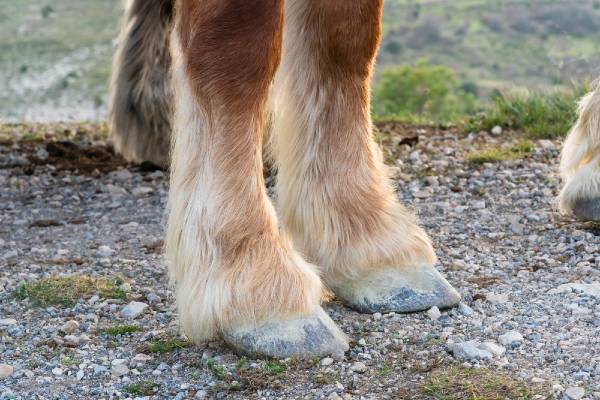
There are also a lot of different parts that are inside a horse’s hoof! Here is a summary of the main parts and their functions:
The Key Parts of a Horses Hoof
- Bones: Each hoof contains two and a half bones. The pedal bone gives the hoof its rigid structure and is the bone closest to the ground. The bottom half of the short pastern bone forms a joint with the coffin bone. This is the joint that allows the hoof to move laterally. Lastly, the navicular bone sits behind the pedal and short pastern joint. Its purpose is to provide a lever for the ligaments and tendons that pass over it. (source)
- Laminae: this is the tissue that connects the hoof wall to the pedal bone.
- Digital cushion: Underneath the pedal bone, you will find the digital cushion. This is a springy shock absorber, which sits directly under the heels and frog.
- Blood vessels: There are many blood vessels that are found either in the hoof or within the pedal bone. This supports the constant growth of the hoof wall. It also helps maintain the laminae and keeps the bond between the hoof wall and pedal bone strong. (source)
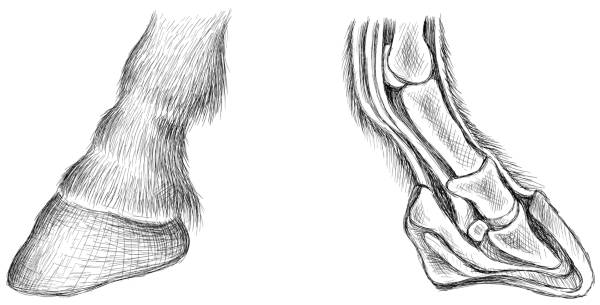
How Do Wild Horses Maintain Their Hooves
Wild horses maintain their hooves by wearing them down as they move around. The wild horse covers large distances each day, which wears down the hoof wall.
Wild horses traverse various terrain, including flat grassy land, rocks, snow, ice, and river crossings. Each of these terrain types helps to maintain the horse’s hoof; but in a different way.
Flat grassy land provides a softer surface for the horse. These areas don’t result in much wear to the hoof, which can be good after long periods of travel. Alternatively, flat dry, or sandy areas can result in a smoothing wear to the hoof wall.
Rocky or stony areas can cause sections of the hoof wall to break off. This is an effective way to remove excessive length of the hoof wall. While it doesn’t always result in a nice smooth hoof wall, these surfaces are much faster at reducing length.
River crossings are an excellent way of providing moisture to the hoof. If the hoof gets too dry, it can be prone to developing chips and cracks. A similar effect is achieved by walking through wet grass. Snow has a similar moisturizing effect but is also abrasive like sand.
In the wild, horses may travel up to 20 or 30 miles a day. They cover such a large distance in search of food and water. This also explains how they regularly encounter different terrain. The landscape changes around them as they travel.
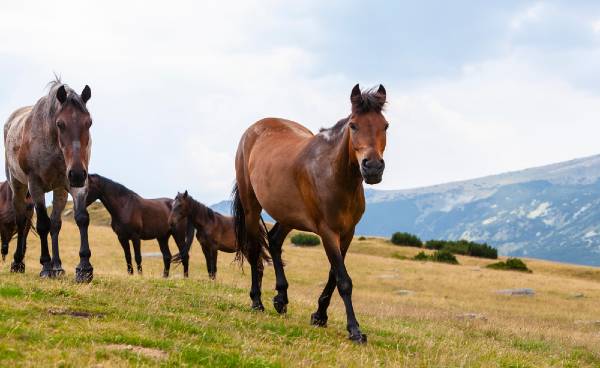
Why Do Domestic Horses Need a Farrier?
Domestic horses are unable to maintain their own hooves. This is because they are unable to cover the same amount of distance as wild horses. Domestic horses are usually kept in fields that are of relatively kind terrain, and some fields are only an acre or two in size.
While domestic horses do still move around, they spend much more of their time in sedentary positions than wild horses. Even if you ride your horse every day, it is unlikely that you will cover enough distance to wear down your horse’s hooves enough naturally.
The farrier’s role is to trim the excess hoof wall back when it starts to get too long. It is generally recommended that domestic horses see a farrier every six to eight weeks. This is a standard timeframe in which most horses’ hooves are getting too long by the end of the period.
Depending on the horse’s activity level, they may need farrier visits more or less often. Horses who go on regular long trail rides or participate in endurance events may require fewer farrier visits. This is because they are regularly covering long distances. They are also more likely to encounter rough terrain during these rides.
Horses who lead a very sedentary life may require visits more often. If your horse is usually stabled, it will most certainly be moving around less. This results in even less wear to the hooves. These horses might need a farrier visit every four to five weeks.
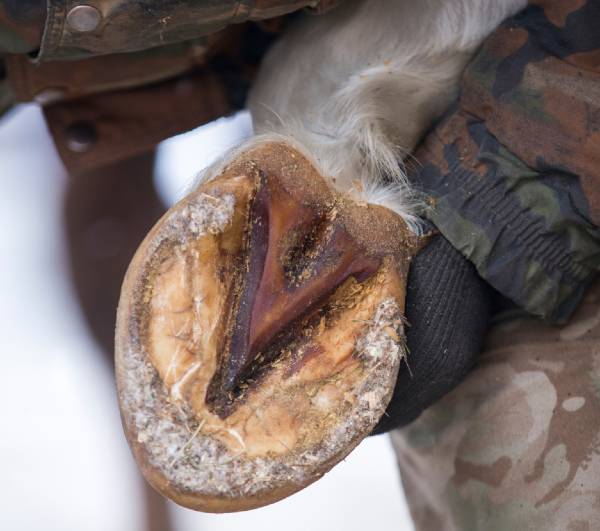
What Happens if Wild Horses Don’t Maintain Their Hooves?
In short, the wild horse that does not maintain their hooves effectively is at a higher risk of death. Poor hoof health doesn’t necessarily cause death; however, it can lead to other causes much faster.
Hoof health is linked to how well a horse can move around. If a wild horse has hooves that are too long or uncomfortable, their movement will be restricted. This means the horse may be unable to keep up with their herd or travel far enough to find food.
If a wild horse becomes isolated from their herd, they are a much easier target for predators. This is especially true if the horse is unable to run away fast enough to escape the predator. If movement prevents the horse from finding food or water, they will eventually die.
The common saying, ‘no hoof, no horse’, is all too true. Without healthy hooves, the well-being of the entire horse is compromised. If the horse cannot move around comfortably, they will move as best they can. This can result in a variety of other issues, due to the horse compensating for their poor feet.
For example, you may be limping if you have a sore foot. If your limp persists long enough or is severe, it will affect other parts of your body. Your back might become sore, or you might injure your other leg due to it bearing all your weight. The same occurs for horses!
Why do Domestic Horses Need Horseshoes?
Horseshoes are thought to have been invented by the Romans, to protect the hooves of their horses. Horseshoes come in a variety of different shapes and can be made out of different materials. Most horseshoes are U-shaped pieces of metal but can be made out of plastic or aluminum. Other shapes incorporate support for the frog or heel. (source)
Domestic horses tend to have softer hooves than wild horses. This means that their hoof wall wears away more rapidly than it can grow. They are also unlikely to be conditioned to hard or stony surfaces. Some horses appear to tip-toe over areas of gravel or concrete if they are especially sensitive.
This is where horseshoes come in. They protect the hoof wall from wearing away too much. They also provide protection from injury on hard, rocky, wet, or muddy ground. Also, they can provide added grip for horses competing in racing or jumping events.
Most high-performance horses wear horseshoes. To ensure they can perform at their peak, their hooves need to be kept perfectly balanced. Using horseshoes prevents the hoof wall from wearing unevenly. It also means the horse is less sensitive to different surfaces whilst out training or competing.
Horseshoes can also be used in a corrective fashion to help improve the horse’s balance. Some horses have conformation issues; which can be aided by specific shoeing practices. Corrective shoeing is often used for a period of time to resolve a particular problem. Once the issue is fixed, the horse can return to normal shoes or be left barefoot.
Some horses permanently require corrective shoeing. These horses have often suffered an injury or disease like ringbone or laminitis that has permanently damaged the area. Corrective shoeing is essential to keep these horses comfortable. (source)
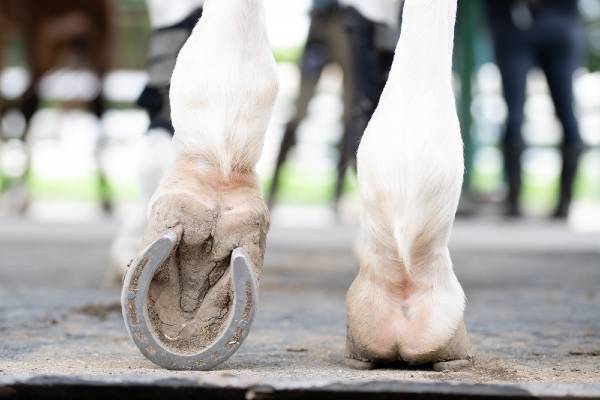
Do Different Breeds of Horse Have Different Hooves?
The basic structure and shape of the hoof are the same across all horse breeds. However, there are sometimes significant differences between horse breeds. Over many years, people have selectively bred horses based on certain desirable traits.
For example, the Clydesdale is bred to have large, flat hooves. This goes back to their origins as a workhorse pulling carts and farm machinery. Clydesdales needed to be able to disperse shock from their pulling efforts effectively. They also used their large hooves for traction in muddy fields.
Comparatively, the Thoroughbred was bred for speed and lightness. Their hooves are lighter and have thinner soles and hoof walls. This likely came about as breeders chose the fastest horses to try and create the next winner. This causes issues when the horse encounters rough ground; they are more likely to become lame or injured.
At times, selectively breeding for specific traits has caused the health of the overall horse to suffer. While Thoroughbreds are fast, they are often high maintenance when it comes to hoof care. Many Thoroughbreds wear horseshoes; to help them cope with any stony surfaces.
Likewise, selectively breeding for small and delicate hooves in the Quarter Horse leads to issues. This is because the Quarter Horse is a heavy horse with a lot of muscle. If the hooves are too small, they have less surface area to support this weight and to disperse shock.
All horse breeds, with correct diet and hoof care, can have healthy hooves. Even if there are injuries or poor genetics, proper hoof care will help keep the horse sound. This is why it is important to use a knowledgeable farrier regularly.
Why Can Wild Horses Maintain Their Hooves, but Domestic Horses Can’t?
While they appear the same from the outside, there are some key differences between domestic and wild horse hooves. For starters, wild horse hooves are generally tougher and harder than domestic horse hooves. There are a couple of reasons for this.
Wild horse populations are all subject to natural selection, or survival of the fittest. This means that only horses who survive are able to breed and produce offspring. Horses that had poor hooves and could not move around effectively were more likely to die.
This results in only wild horses with healthy hooves being able to breed. The genetics for healthy and strong hooves are passed onto their offspring, and so on. When we breed domestic horses, we are often looking at other traits. This can result in less-than-ideal hoof genetics being passed on.
Wild horses are also used to traveling across a wide variety of terrain. Domestic horses often only experience areas like soft grassy paddocks, arenas, and stables. The wild horse constantly conditions their feet on different surfaces as they move around. The domestic horse does not have the same opportunities.

Additionally, wild horse hooves may not grow as rapidly as domestic horse hooves. This is because wild horses generally have a poorer diet than domestic horses. Wild horses survive on what they can find, and their diet is entirely made up of grass, bushes, or sometimes bark. You can read more about what horses eat in the wild here.
While this supports survival, it doesn’t necessarily provide anything extra in terms of vitamins and minerals. Comparatively, the domestic horse is usually fed a balanced concentrate feed or vitamin and mineral supplement. These horses are very unlikely to be lacking in any part of their diet, and there are more resources available for their body to use to support hoof growth.
Injuries That Can Affect the Horse Hoof
Here are some of the common injuries that can affect a horse’s hooves:
- Bruises: this occurs when the horse steps on something, usually a stone, and it bruises the sole. The horse may be slightly or severely lame, depending on how bad the bruise is. Once the bruise heals, the horse will be back to normal.
- Abscesses: these are small infections inside the hoof, that until they are drained, are extremely painful. They are caused by dirt or bacteria working their way inside the hoof. Common points of entry include along the white line, or a puncture wound to the sole or frog.
- Cracks: hooves that are not maintained can develop cracks in the hoof wall. Small cracks generally do not cause too many problems, however, can progress to become large ones. Large cracks can expose the sensitive laminae and be very hard to fix once they have developed.
- Thrush: this is a painful bacterial infection that affects the frog. Bacteria degrades the frog and causes pain to the horse. It is more common in horses living in muddy paddocks or stalls that are not very clean.
- Laminitis: this occurs when the laminae become weakened and inflamed. At best, it causes short-term pain until the inflammation reduces. At worst, the pedal bone moves away or detaches from the hoof wall. The most common cause of laminitis is a diet too high in sugar. Other causes include recent illness, excessive weight bearing, or too much work on a very hard surface.
- Navicular syndrome: this occurs when the navicular bone is inflamed or damaged in some way. This causes varying degrees of pain and makes it harder for the tendons and ligaments to function normally.
Final Thoughts
Wild horses maintain their hooves through natural wear and tear, due to the large distances they travel each day. They also encounter a variety of different terrain, which further assists with keeping hoof length in check. Domestic horses often live in much softer environments and require regular hoof care to keep their hooves in shape.

